HRM Challenges, Reward Systems, and Performance at Tesco
VerifiedAdded on 2023/04/24
|10
|2934
|380
Report
AI Summary
This report delves into the multifaceted challenges that multinational corporations (MNCs) encounter in Human Resource Management (HRM), emphasizing the complexities arising from diverse cultural backgrounds, employment laws, and educational systems across different countries. The report highlights issues such as varying HR policies, recruitment practices, and employee relations, using examples like the differences between the US and Bangladesh, and Japan and the UK. It then analyzes Tesco's approach to employee rewards, detailing its objectives, principles (competitive, simple, fair, sustainable), and key reward choices, including annual bonuses, share incentives, and colleague shareholding schemes. The report explores the impact of these reward strategies on individual performance, emphasizing the positive influence of annual bonuses, share incentives, and employee ownership on motivation and teamwork. Finally, it suggests improvements, such as implementing monthly incentives and enhanced training programs, to further boost employee performance and align with employee expectations.
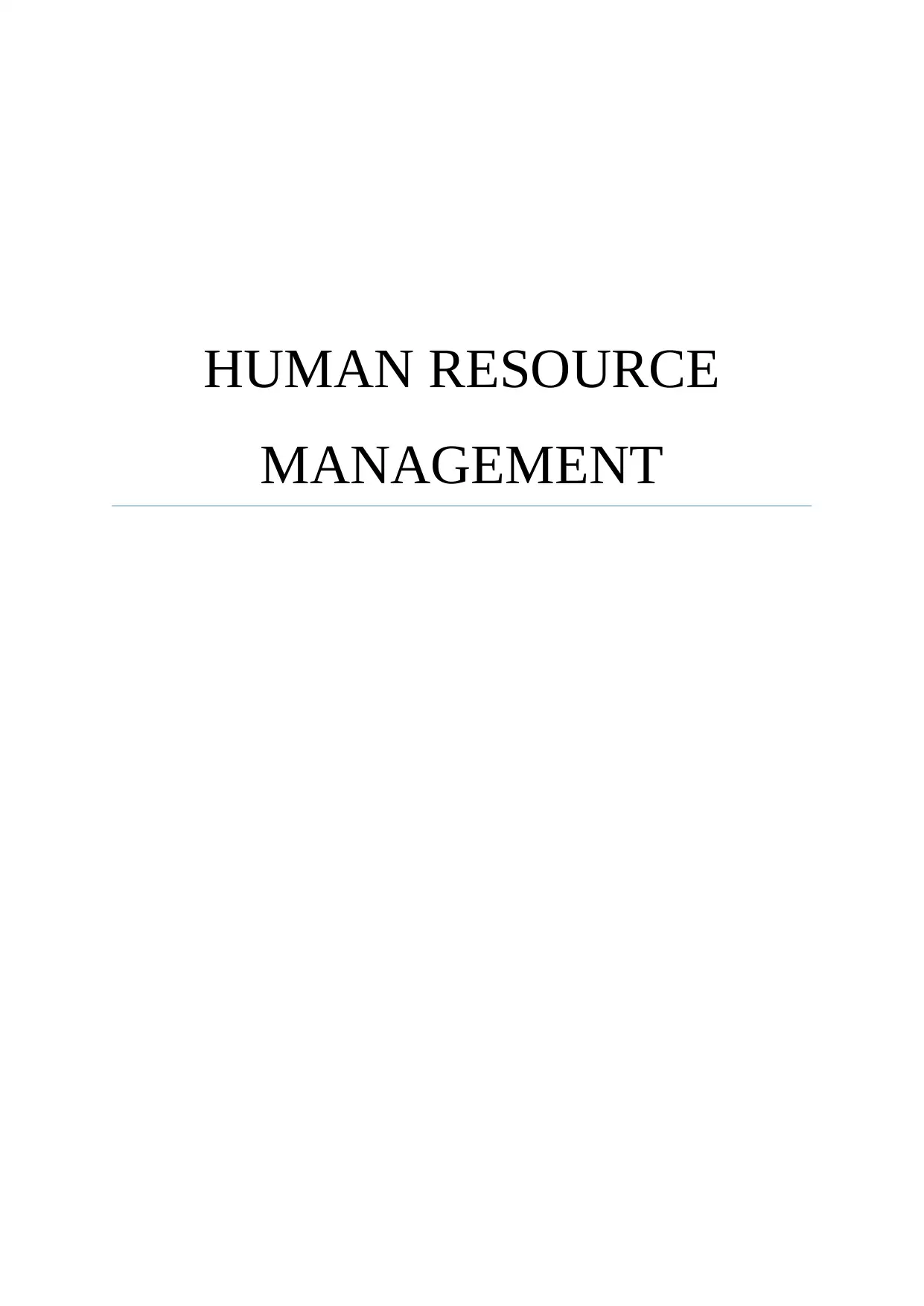
HUMAN RESOURCE
MANAGEMENT
MANAGEMENT
Paraphrase This Document
Need a fresh take? Get an instant paraphrase of this document with our AI Paraphraser
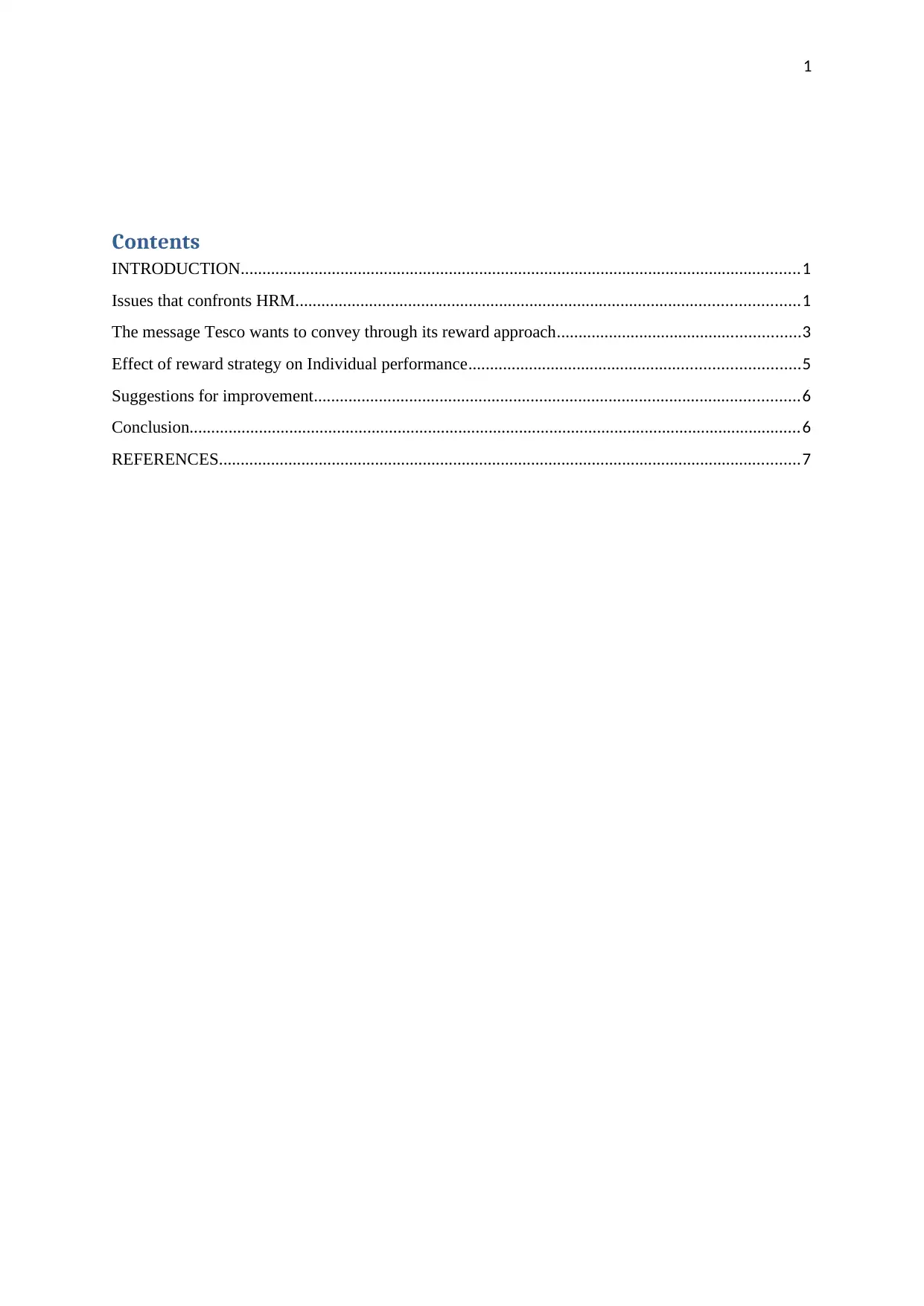
1
Contents
INTRODUCTION.................................................................................................................................1
Issues that confronts HRM....................................................................................................................1
The message Tesco wants to convey through its reward approach........................................................3
Effect of reward strategy on Individual performance............................................................................5
Suggestions for improvement................................................................................................................6
Conclusion.............................................................................................................................................6
REFERENCES......................................................................................................................................7
Contents
INTRODUCTION.................................................................................................................................1
Issues that confronts HRM....................................................................................................................1
The message Tesco wants to convey through its reward approach........................................................3
Effect of reward strategy on Individual performance............................................................................5
Suggestions for improvement................................................................................................................6
Conclusion.............................................................................................................................................6
REFERENCES......................................................................................................................................7
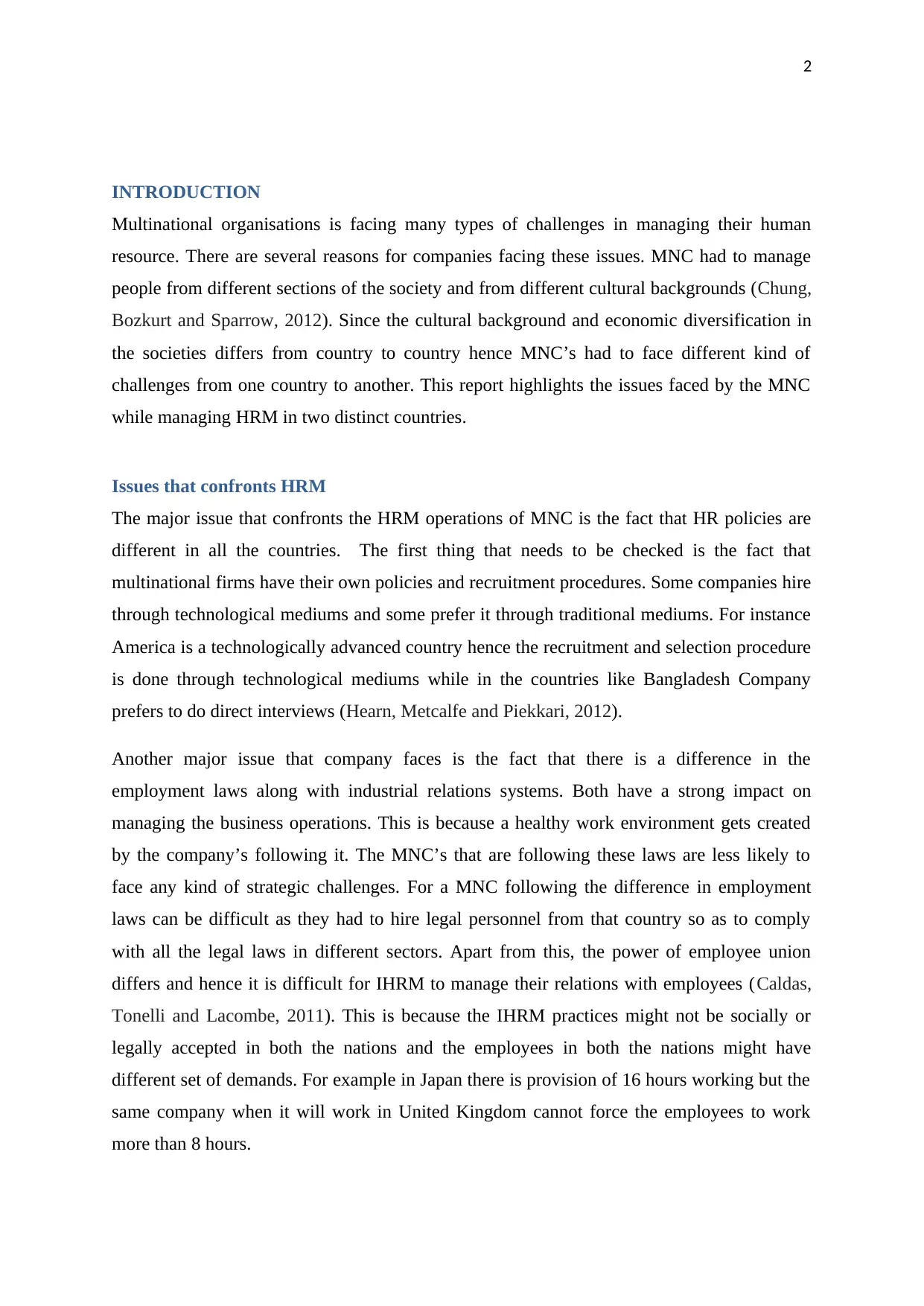
2
INTRODUCTION
Multinational organisations is facing many types of challenges in managing their human
resource. There are several reasons for companies facing these issues. MNC had to manage
people from different sections of the society and from different cultural backgrounds (Chung,
Bozkurt and Sparrow, 2012). Since the cultural background and economic diversification in
the societies differs from country to country hence MNC’s had to face different kind of
challenges from one country to another. This report highlights the issues faced by the MNC
while managing HRM in two distinct countries.
Issues that confronts HRM
The major issue that confronts the HRM operations of MNC is the fact that HR policies are
different in all the countries. The first thing that needs to be checked is the fact that
multinational firms have their own policies and recruitment procedures. Some companies hire
through technological mediums and some prefer it through traditional mediums. For instance
America is a technologically advanced country hence the recruitment and selection procedure
is done through technological mediums while in the countries like Bangladesh Company
prefers to do direct interviews (Hearn, Metcalfe and Piekkari, 2012).
Another major issue that company faces is the fact that there is a difference in the
employment laws along with industrial relations systems. Both have a strong impact on
managing the business operations. This is because a healthy work environment gets created
by the company’s following it. The MNC’s that are following these laws are less likely to
face any kind of strategic challenges. For a MNC following the difference in employment
laws can be difficult as they had to hire legal personnel from that country so as to comply
with all the legal laws in different sectors. Apart from this, the power of employee union
differs and hence it is difficult for IHRM to manage their relations with employees (Caldas,
Tonelli and Lacombe, 2011). This is because the IHRM practices might not be socially or
legally accepted in both the nations and the employees in both the nations might have
different set of demands. For example in Japan there is provision of 16 hours working but the
same company when it will work in United Kingdom cannot force the employees to work
more than 8 hours.
INTRODUCTION
Multinational organisations is facing many types of challenges in managing their human
resource. There are several reasons for companies facing these issues. MNC had to manage
people from different sections of the society and from different cultural backgrounds (Chung,
Bozkurt and Sparrow, 2012). Since the cultural background and economic diversification in
the societies differs from country to country hence MNC’s had to face different kind of
challenges from one country to another. This report highlights the issues faced by the MNC
while managing HRM in two distinct countries.
Issues that confronts HRM
The major issue that confronts the HRM operations of MNC is the fact that HR policies are
different in all the countries. The first thing that needs to be checked is the fact that
multinational firms have their own policies and recruitment procedures. Some companies hire
through technological mediums and some prefer it through traditional mediums. For instance
America is a technologically advanced country hence the recruitment and selection procedure
is done through technological mediums while in the countries like Bangladesh Company
prefers to do direct interviews (Hearn, Metcalfe and Piekkari, 2012).
Another major issue that company faces is the fact that there is a difference in the
employment laws along with industrial relations systems. Both have a strong impact on
managing the business operations. This is because a healthy work environment gets created
by the company’s following it. The MNC’s that are following these laws are less likely to
face any kind of strategic challenges. For a MNC following the difference in employment
laws can be difficult as they had to hire legal personnel from that country so as to comply
with all the legal laws in different sectors. Apart from this, the power of employee union
differs and hence it is difficult for IHRM to manage their relations with employees (Caldas,
Tonelli and Lacombe, 2011). This is because the IHRM practices might not be socially or
legally accepted in both the nations and the employees in both the nations might have
different set of demands. For example in Japan there is provision of 16 hours working but the
same company when it will work in United Kingdom cannot force the employees to work
more than 8 hours.
⊘ This is a preview!⊘
Do you want full access?
Subscribe today to unlock all pages.

Trusted by 1+ million students worldwide
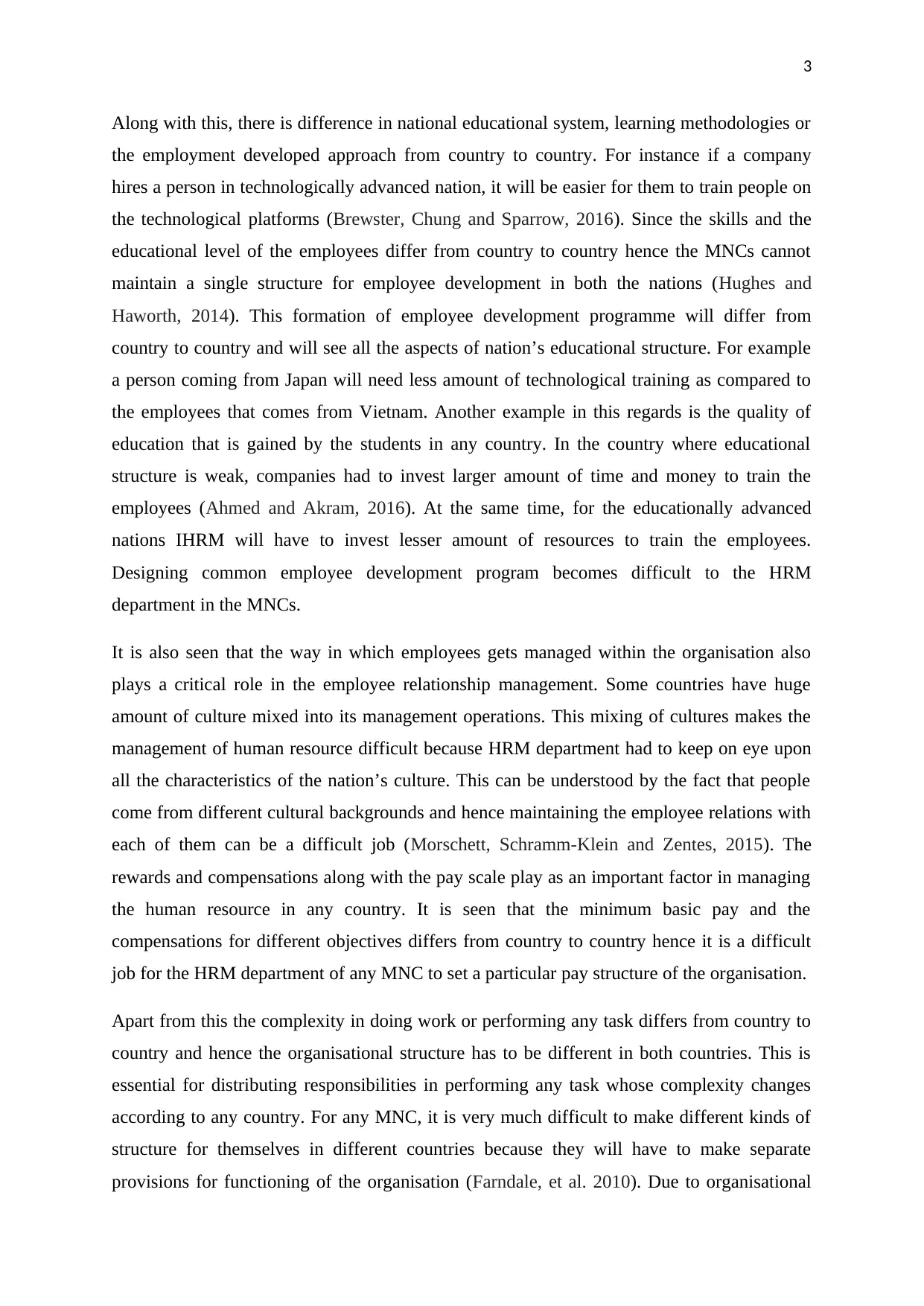
3
Along with this, there is difference in national educational system, learning methodologies or
the employment developed approach from country to country. For instance if a company
hires a person in technologically advanced nation, it will be easier for them to train people on
the technological platforms (Brewster, Chung and Sparrow, 2016). Since the skills and the
educational level of the employees differ from country to country hence the MNCs cannot
maintain a single structure for employee development in both the nations (Hughes and
Haworth, 2014). This formation of employee development programme will differ from
country to country and will see all the aspects of nation’s educational structure. For example
a person coming from Japan will need less amount of technological training as compared to
the employees that comes from Vietnam. Another example in this regards is the quality of
education that is gained by the students in any country. In the country where educational
structure is weak, companies had to invest larger amount of time and money to train the
employees (Ahmed and Akram, 2016). At the same time, for the educationally advanced
nations IHRM will have to invest lesser amount of resources to train the employees.
Designing common employee development program becomes difficult to the HRM
department in the MNCs.
It is also seen that the way in which employees gets managed within the organisation also
plays a critical role in the employee relationship management. Some countries have huge
amount of culture mixed into its management operations. This mixing of cultures makes the
management of human resource difficult because HRM department had to keep on eye upon
all the characteristics of the nation’s culture. This can be understood by the fact that people
come from different cultural backgrounds and hence maintaining the employee relations with
each of them can be a difficult job (Morschett, Schramm-Klein and Zentes, 2015). The
rewards and compensations along with the pay scale play as an important factor in managing
the human resource in any country. It is seen that the minimum basic pay and the
compensations for different objectives differs from country to country hence it is a difficult
job for the HRM department of any MNC to set a particular pay structure of the organisation.
Apart from this the complexity in doing work or performing any task differs from country to
country and hence the organisational structure has to be different in both countries. This is
essential for distributing responsibilities in performing any task whose complexity changes
according to any country. For any MNC, it is very much difficult to make different kinds of
structure for themselves in different countries because they will have to make separate
provisions for functioning of the organisation (Farndale, et al. 2010). Due to organisational
Along with this, there is difference in national educational system, learning methodologies or
the employment developed approach from country to country. For instance if a company
hires a person in technologically advanced nation, it will be easier for them to train people on
the technological platforms (Brewster, Chung and Sparrow, 2016). Since the skills and the
educational level of the employees differ from country to country hence the MNCs cannot
maintain a single structure for employee development in both the nations (Hughes and
Haworth, 2014). This formation of employee development programme will differ from
country to country and will see all the aspects of nation’s educational structure. For example
a person coming from Japan will need less amount of technological training as compared to
the employees that comes from Vietnam. Another example in this regards is the quality of
education that is gained by the students in any country. In the country where educational
structure is weak, companies had to invest larger amount of time and money to train the
employees (Ahmed and Akram, 2016). At the same time, for the educationally advanced
nations IHRM will have to invest lesser amount of resources to train the employees.
Designing common employee development program becomes difficult to the HRM
department in the MNCs.
It is also seen that the way in which employees gets managed within the organisation also
plays a critical role in the employee relationship management. Some countries have huge
amount of culture mixed into its management operations. This mixing of cultures makes the
management of human resource difficult because HRM department had to keep on eye upon
all the characteristics of the nation’s culture. This can be understood by the fact that people
come from different cultural backgrounds and hence maintaining the employee relations with
each of them can be a difficult job (Morschett, Schramm-Klein and Zentes, 2015). The
rewards and compensations along with the pay scale play as an important factor in managing
the human resource in any country. It is seen that the minimum basic pay and the
compensations for different objectives differs from country to country hence it is a difficult
job for the HRM department of any MNC to set a particular pay structure of the organisation.
Apart from this the complexity in doing work or performing any task differs from country to
country and hence the organisational structure has to be different in both countries. This is
essential for distributing responsibilities in performing any task whose complexity changes
according to any country. For any MNC, it is very much difficult to make different kinds of
structure for themselves in different countries because they will have to make separate
provisions for functioning of the organisation (Farndale, et al. 2010). Due to organisational
Paraphrase This Document
Need a fresh take? Get an instant paraphrase of this document with our AI Paraphraser
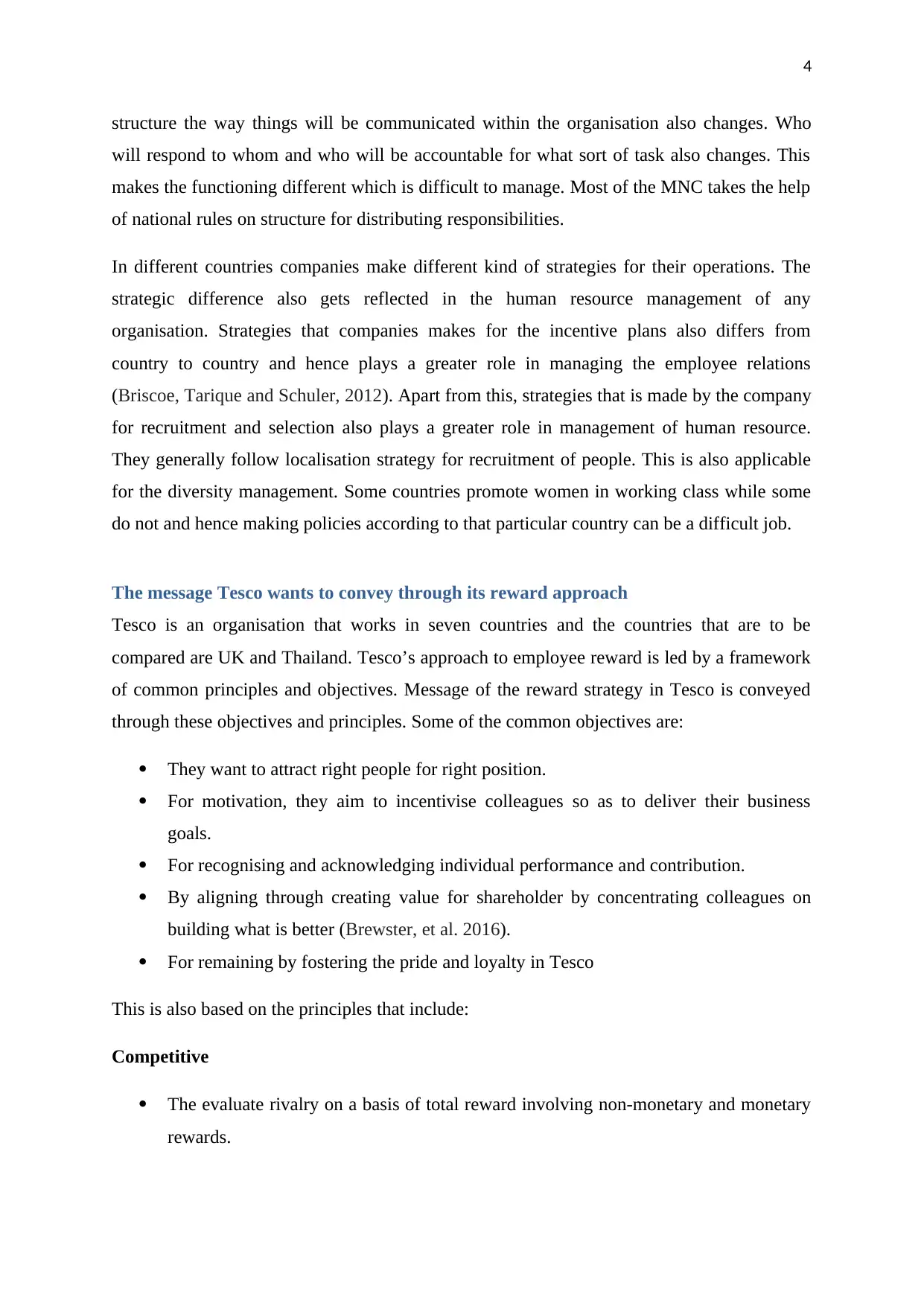
4
structure the way things will be communicated within the organisation also changes. Who
will respond to whom and who will be accountable for what sort of task also changes. This
makes the functioning different which is difficult to manage. Most of the MNC takes the help
of national rules on structure for distributing responsibilities.
In different countries companies make different kind of strategies for their operations. The
strategic difference also gets reflected in the human resource management of any
organisation. Strategies that companies makes for the incentive plans also differs from
country to country and hence plays a greater role in managing the employee relations
(Briscoe, Tarique and Schuler, 2012). Apart from this, strategies that is made by the company
for recruitment and selection also plays a greater role in management of human resource.
They generally follow localisation strategy for recruitment of people. This is also applicable
for the diversity management. Some countries promote women in working class while some
do not and hence making policies according to that particular country can be a difficult job.
The message Tesco wants to convey through its reward approach
Tesco is an organisation that works in seven countries and the countries that are to be
compared are UK and Thailand. Tesco’s approach to employee reward is led by a framework
of common principles and objectives. Message of the reward strategy in Tesco is conveyed
through these objectives and principles. Some of the common objectives are:
They want to attract right people for right position.
For motivation, they aim to incentivise colleagues so as to deliver their business
goals.
For recognising and acknowledging individual performance and contribution.
By aligning through creating value for shareholder by concentrating colleagues on
building what is better (Brewster, et al. 2016).
For remaining by fostering the pride and loyalty in Tesco
This is also based on the principles that include:
Competitive
The evaluate rivalry on a basis of total reward involving non-monetary and monetary
rewards.
structure the way things will be communicated within the organisation also changes. Who
will respond to whom and who will be accountable for what sort of task also changes. This
makes the functioning different which is difficult to manage. Most of the MNC takes the help
of national rules on structure for distributing responsibilities.
In different countries companies make different kind of strategies for their operations. The
strategic difference also gets reflected in the human resource management of any
organisation. Strategies that companies makes for the incentive plans also differs from
country to country and hence plays a greater role in managing the employee relations
(Briscoe, Tarique and Schuler, 2012). Apart from this, strategies that is made by the company
for recruitment and selection also plays a greater role in management of human resource.
They generally follow localisation strategy for recruitment of people. This is also applicable
for the diversity management. Some countries promote women in working class while some
do not and hence making policies according to that particular country can be a difficult job.
The message Tesco wants to convey through its reward approach
Tesco is an organisation that works in seven countries and the countries that are to be
compared are UK and Thailand. Tesco’s approach to employee reward is led by a framework
of common principles and objectives. Message of the reward strategy in Tesco is conveyed
through these objectives and principles. Some of the common objectives are:
They want to attract right people for right position.
For motivation, they aim to incentivise colleagues so as to deliver their business
goals.
For recognising and acknowledging individual performance and contribution.
By aligning through creating value for shareholder by concentrating colleagues on
building what is better (Brewster, et al. 2016).
For remaining by fostering the pride and loyalty in Tesco
This is also based on the principles that include:
Competitive
The evaluate rivalry on a basis of total reward involving non-monetary and monetary
rewards.
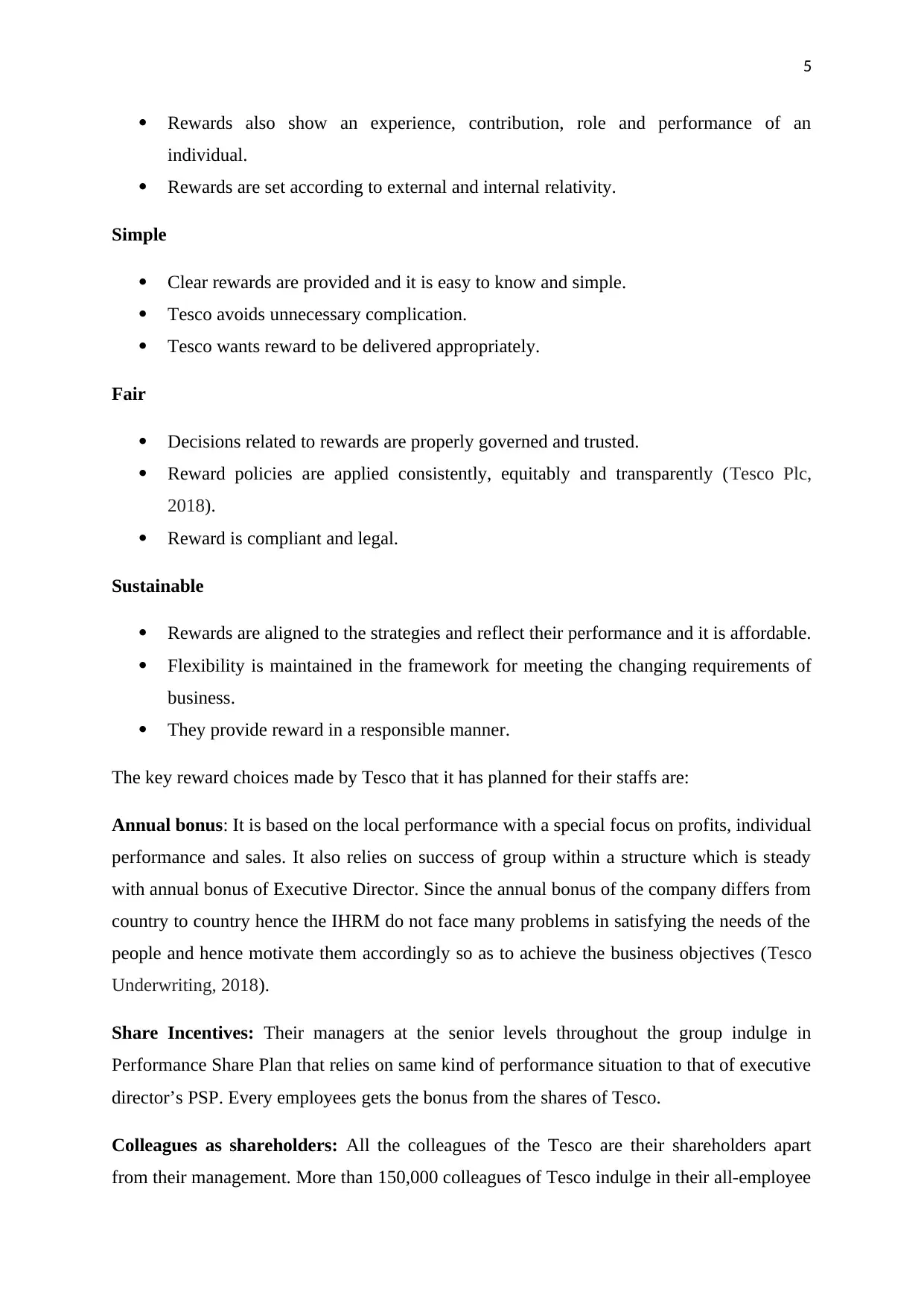
5
Rewards also show an experience, contribution, role and performance of an
individual.
Rewards are set according to external and internal relativity.
Simple
Clear rewards are provided and it is easy to know and simple.
Tesco avoids unnecessary complication.
Tesco wants reward to be delivered appropriately.
Fair
Decisions related to rewards are properly governed and trusted.
Reward policies are applied consistently, equitably and transparently (Tesco Plc,
2018).
Reward is compliant and legal.
Sustainable
Rewards are aligned to the strategies and reflect their performance and it is affordable.
Flexibility is maintained in the framework for meeting the changing requirements of
business.
They provide reward in a responsible manner.
The key reward choices made by Tesco that it has planned for their staffs are:
Annual bonus: It is based on the local performance with a special focus on profits, individual
performance and sales. It also relies on success of group within a structure which is steady
with annual bonus of Executive Director. Since the annual bonus of the company differs from
country to country hence the IHRM do not face many problems in satisfying the needs of the
people and hence motivate them accordingly so as to achieve the business objectives (Tesco
Underwriting, 2018).
Share Incentives: Their managers at the senior levels throughout the group indulge in
Performance Share Plan that relies on same kind of performance situation to that of executive
director’s PSP. Every employees gets the bonus from the shares of Tesco.
Colleagues as shareholders: All the colleagues of the Tesco are their shareholders apart
from their management. More than 150,000 colleagues of Tesco indulge in their all-employee
Rewards also show an experience, contribution, role and performance of an
individual.
Rewards are set according to external and internal relativity.
Simple
Clear rewards are provided and it is easy to know and simple.
Tesco avoids unnecessary complication.
Tesco wants reward to be delivered appropriately.
Fair
Decisions related to rewards are properly governed and trusted.
Reward policies are applied consistently, equitably and transparently (Tesco Plc,
2018).
Reward is compliant and legal.
Sustainable
Rewards are aligned to the strategies and reflect their performance and it is affordable.
Flexibility is maintained in the framework for meeting the changing requirements of
business.
They provide reward in a responsible manner.
The key reward choices made by Tesco that it has planned for their staffs are:
Annual bonus: It is based on the local performance with a special focus on profits, individual
performance and sales. It also relies on success of group within a structure which is steady
with annual bonus of Executive Director. Since the annual bonus of the company differs from
country to country hence the IHRM do not face many problems in satisfying the needs of the
people and hence motivate them accordingly so as to achieve the business objectives (Tesco
Underwriting, 2018).
Share Incentives: Their managers at the senior levels throughout the group indulge in
Performance Share Plan that relies on same kind of performance situation to that of executive
director’s PSP. Every employees gets the bonus from the shares of Tesco.
Colleagues as shareholders: All the colleagues of the Tesco are their shareholders apart
from their management. More than 150,000 colleagues of Tesco indulge in their all-employee
⊘ This is a preview!⊘
Do you want full access?
Subscribe today to unlock all pages.

Trusted by 1+ million students worldwide
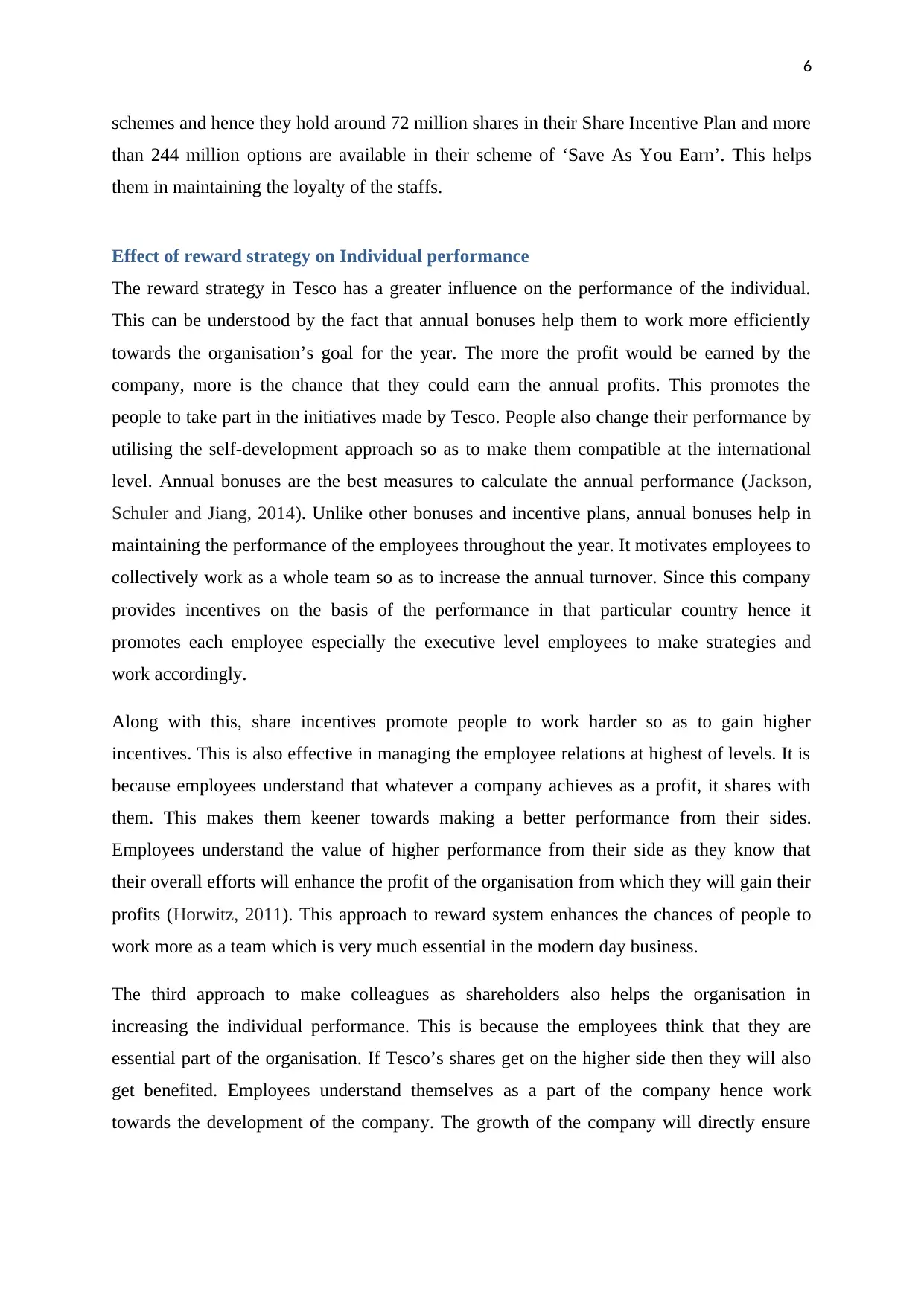
6
schemes and hence they hold around 72 million shares in their Share Incentive Plan and more
than 244 million options are available in their scheme of ‘Save As You Earn’. This helps
them in maintaining the loyalty of the staffs.
Effect of reward strategy on Individual performance
The reward strategy in Tesco has a greater influence on the performance of the individual.
This can be understood by the fact that annual bonuses help them to work more efficiently
towards the organisation’s goal for the year. The more the profit would be earned by the
company, more is the chance that they could earn the annual profits. This promotes the
people to take part in the initiatives made by Tesco. People also change their performance by
utilising the self-development approach so as to make them compatible at the international
level. Annual bonuses are the best measures to calculate the annual performance (Jackson,
Schuler and Jiang, 2014). Unlike other bonuses and incentive plans, annual bonuses help in
maintaining the performance of the employees throughout the year. It motivates employees to
collectively work as a whole team so as to increase the annual turnover. Since this company
provides incentives on the basis of the performance in that particular country hence it
promotes each employee especially the executive level employees to make strategies and
work accordingly.
Along with this, share incentives promote people to work harder so as to gain higher
incentives. This is also effective in managing the employee relations at highest of levels. It is
because employees understand that whatever a company achieves as a profit, it shares with
them. This makes them keener towards making a better performance from their sides.
Employees understand the value of higher performance from their side as they know that
their overall efforts will enhance the profit of the organisation from which they will gain their
profits (Horwitz, 2011). This approach to reward system enhances the chances of people to
work more as a team which is very much essential in the modern day business.
The third approach to make colleagues as shareholders also helps the organisation in
increasing the individual performance. This is because the employees think that they are
essential part of the organisation. If Tesco’s shares get on the higher side then they will also
get benefited. Employees understand themselves as a part of the company hence work
towards the development of the company. The growth of the company will directly ensure
schemes and hence they hold around 72 million shares in their Share Incentive Plan and more
than 244 million options are available in their scheme of ‘Save As You Earn’. This helps
them in maintaining the loyalty of the staffs.
Effect of reward strategy on Individual performance
The reward strategy in Tesco has a greater influence on the performance of the individual.
This can be understood by the fact that annual bonuses help them to work more efficiently
towards the organisation’s goal for the year. The more the profit would be earned by the
company, more is the chance that they could earn the annual profits. This promotes the
people to take part in the initiatives made by Tesco. People also change their performance by
utilising the self-development approach so as to make them compatible at the international
level. Annual bonuses are the best measures to calculate the annual performance (Jackson,
Schuler and Jiang, 2014). Unlike other bonuses and incentive plans, annual bonuses help in
maintaining the performance of the employees throughout the year. It motivates employees to
collectively work as a whole team so as to increase the annual turnover. Since this company
provides incentives on the basis of the performance in that particular country hence it
promotes each employee especially the executive level employees to make strategies and
work accordingly.
Along with this, share incentives promote people to work harder so as to gain higher
incentives. This is also effective in managing the employee relations at highest of levels. It is
because employees understand that whatever a company achieves as a profit, it shares with
them. This makes them keener towards making a better performance from their sides.
Employees understand the value of higher performance from their side as they know that
their overall efforts will enhance the profit of the organisation from which they will gain their
profits (Horwitz, 2011). This approach to reward system enhances the chances of people to
work more as a team which is very much essential in the modern day business.
The third approach to make colleagues as shareholders also helps the organisation in
increasing the individual performance. This is because the employees think that they are
essential part of the organisation. If Tesco’s shares get on the higher side then they will also
get benefited. Employees understand themselves as a part of the company hence work
towards the development of the company. The growth of the company will directly ensure
Paraphrase This Document
Need a fresh take? Get an instant paraphrase of this document with our AI Paraphraser
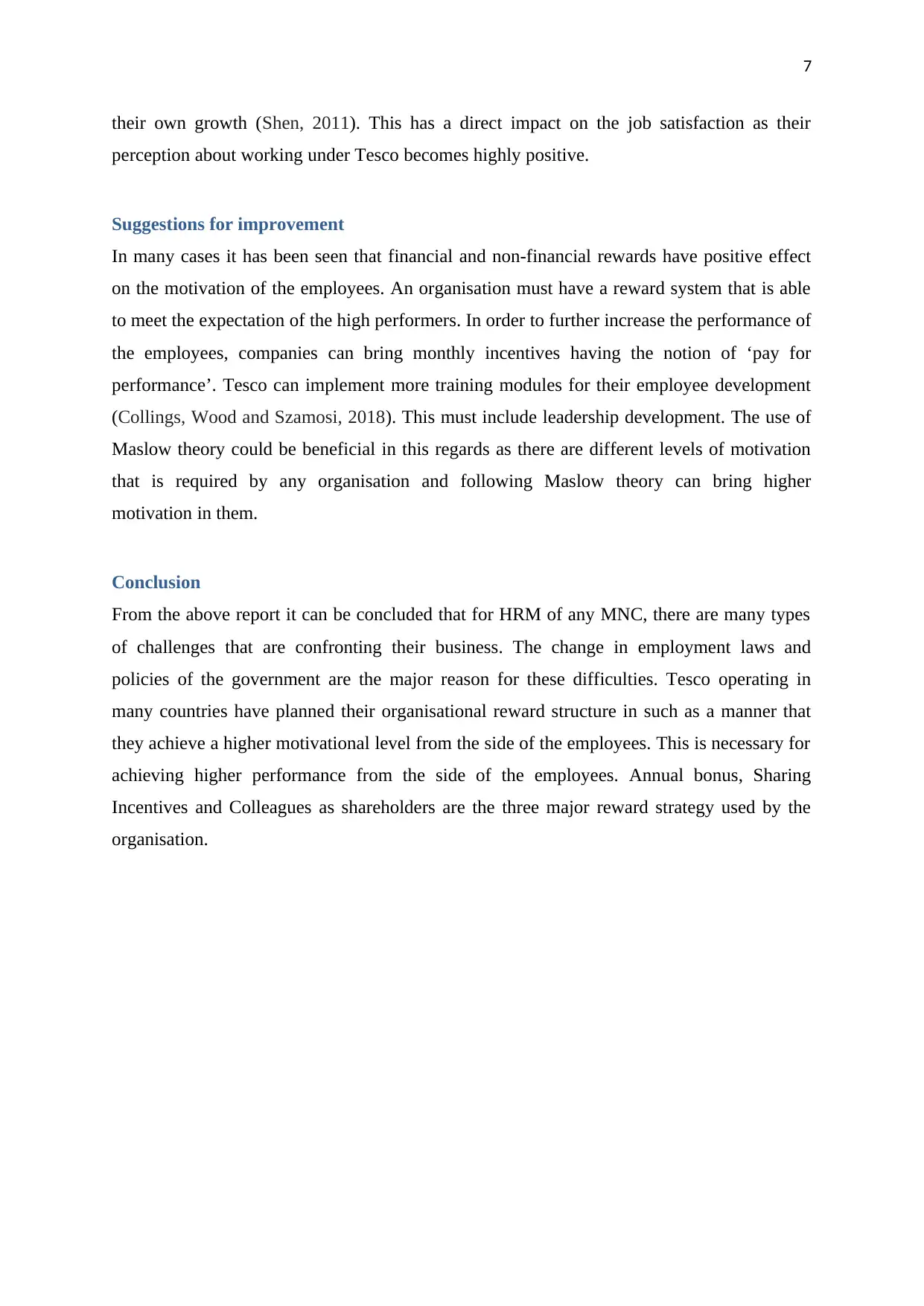
7
their own growth (Shen, 2011). This has a direct impact on the job satisfaction as their
perception about working under Tesco becomes highly positive.
Suggestions for improvement
In many cases it has been seen that financial and non-financial rewards have positive effect
on the motivation of the employees. An organisation must have a reward system that is able
to meet the expectation of the high performers. In order to further increase the performance of
the employees, companies can bring monthly incentives having the notion of ‘pay for
performance’. Tesco can implement more training modules for their employee development
(Collings, Wood and Szamosi, 2018). This must include leadership development. The use of
Maslow theory could be beneficial in this regards as there are different levels of motivation
that is required by any organisation and following Maslow theory can bring higher
motivation in them.
Conclusion
From the above report it can be concluded that for HRM of any MNC, there are many types
of challenges that are confronting their business. The change in employment laws and
policies of the government are the major reason for these difficulties. Tesco operating in
many countries have planned their organisational reward structure in such as a manner that
they achieve a higher motivational level from the side of the employees. This is necessary for
achieving higher performance from the side of the employees. Annual bonus, Sharing
Incentives and Colleagues as shareholders are the three major reward strategy used by the
organisation.
their own growth (Shen, 2011). This has a direct impact on the job satisfaction as their
perception about working under Tesco becomes highly positive.
Suggestions for improvement
In many cases it has been seen that financial and non-financial rewards have positive effect
on the motivation of the employees. An organisation must have a reward system that is able
to meet the expectation of the high performers. In order to further increase the performance of
the employees, companies can bring monthly incentives having the notion of ‘pay for
performance’. Tesco can implement more training modules for their employee development
(Collings, Wood and Szamosi, 2018). This must include leadership development. The use of
Maslow theory could be beneficial in this regards as there are different levels of motivation
that is required by any organisation and following Maslow theory can bring higher
motivation in them.
Conclusion
From the above report it can be concluded that for HRM of any MNC, there are many types
of challenges that are confronting their business. The change in employment laws and
policies of the government are the major reason for these difficulties. Tesco operating in
many countries have planned their organisational reward structure in such as a manner that
they achieve a higher motivational level from the side of the employees. This is necessary for
achieving higher performance from the side of the employees. Annual bonus, Sharing
Incentives and Colleagues as shareholders are the three major reward strategy used by the
organisation.
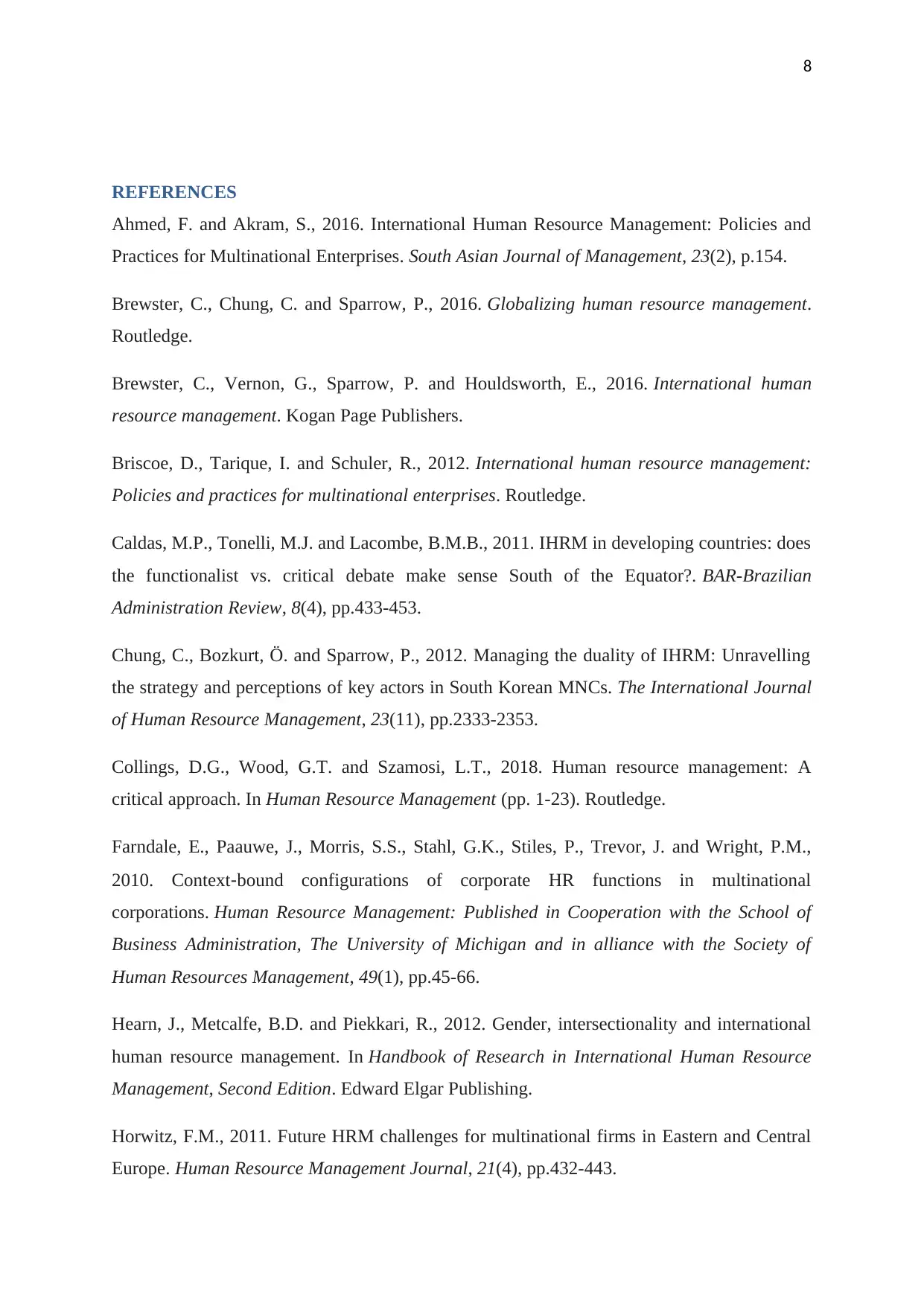
8
REFERENCES
Ahmed, F. and Akram, S., 2016. International Human Resource Management: Policies and
Practices for Multinational Enterprises. South Asian Journal of Management, 23(2), p.154.
Brewster, C., Chung, C. and Sparrow, P., 2016. Globalizing human resource management.
Routledge.
Brewster, C., Vernon, G., Sparrow, P. and Houldsworth, E., 2016. International human
resource management. Kogan Page Publishers.
Briscoe, D., Tarique, I. and Schuler, R., 2012. International human resource management:
Policies and practices for multinational enterprises. Routledge.
Caldas, M.P., Tonelli, M.J. and Lacombe, B.M.B., 2011. IHRM in developing countries: does
the functionalist vs. critical debate make sense South of the Equator?. BAR-Brazilian
Administration Review, 8(4), pp.433-453.
Chung, C., Bozkurt, Ö. and Sparrow, P., 2012. Managing the duality of IHRM: Unravelling
the strategy and perceptions of key actors in South Korean MNCs. The International Journal
of Human Resource Management, 23(11), pp.2333-2353.
Collings, D.G., Wood, G.T. and Szamosi, L.T., 2018. Human resource management: A
critical approach. In Human Resource Management (pp. 1-23). Routledge.
Farndale, E., Paauwe, J., Morris, S.S., Stahl, G.K., Stiles, P., Trevor, J. and Wright, P.M.,
2010. Context‐bound configurations of corporate HR functions in multinational
corporations. Human Resource Management: Published in Cooperation with the School of
Business Administration, The University of Michigan and in alliance with the Society of
Human Resources Management, 49(1), pp.45-66.
Hearn, J., Metcalfe, B.D. and Piekkari, R., 2012. Gender, intersectionality and international
human resource management. In Handbook of Research in International Human Resource
Management, Second Edition. Edward Elgar Publishing.
Horwitz, F.M., 2011. Future HRM challenges for multinational firms in Eastern and Central
Europe. Human Resource Management Journal, 21(4), pp.432-443.
REFERENCES
Ahmed, F. and Akram, S., 2016. International Human Resource Management: Policies and
Practices for Multinational Enterprises. South Asian Journal of Management, 23(2), p.154.
Brewster, C., Chung, C. and Sparrow, P., 2016. Globalizing human resource management.
Routledge.
Brewster, C., Vernon, G., Sparrow, P. and Houldsworth, E., 2016. International human
resource management. Kogan Page Publishers.
Briscoe, D., Tarique, I. and Schuler, R., 2012. International human resource management:
Policies and practices for multinational enterprises. Routledge.
Caldas, M.P., Tonelli, M.J. and Lacombe, B.M.B., 2011. IHRM in developing countries: does
the functionalist vs. critical debate make sense South of the Equator?. BAR-Brazilian
Administration Review, 8(4), pp.433-453.
Chung, C., Bozkurt, Ö. and Sparrow, P., 2012. Managing the duality of IHRM: Unravelling
the strategy and perceptions of key actors in South Korean MNCs. The International Journal
of Human Resource Management, 23(11), pp.2333-2353.
Collings, D.G., Wood, G.T. and Szamosi, L.T., 2018. Human resource management: A
critical approach. In Human Resource Management (pp. 1-23). Routledge.
Farndale, E., Paauwe, J., Morris, S.S., Stahl, G.K., Stiles, P., Trevor, J. and Wright, P.M.,
2010. Context‐bound configurations of corporate HR functions in multinational
corporations. Human Resource Management: Published in Cooperation with the School of
Business Administration, The University of Michigan and in alliance with the Society of
Human Resources Management, 49(1), pp.45-66.
Hearn, J., Metcalfe, B.D. and Piekkari, R., 2012. Gender, intersectionality and international
human resource management. In Handbook of Research in International Human Resource
Management, Second Edition. Edward Elgar Publishing.
Horwitz, F.M., 2011. Future HRM challenges for multinational firms in Eastern and Central
Europe. Human Resource Management Journal, 21(4), pp.432-443.
⊘ This is a preview!⊘
Do you want full access?
Subscribe today to unlock all pages.

Trusted by 1+ million students worldwide
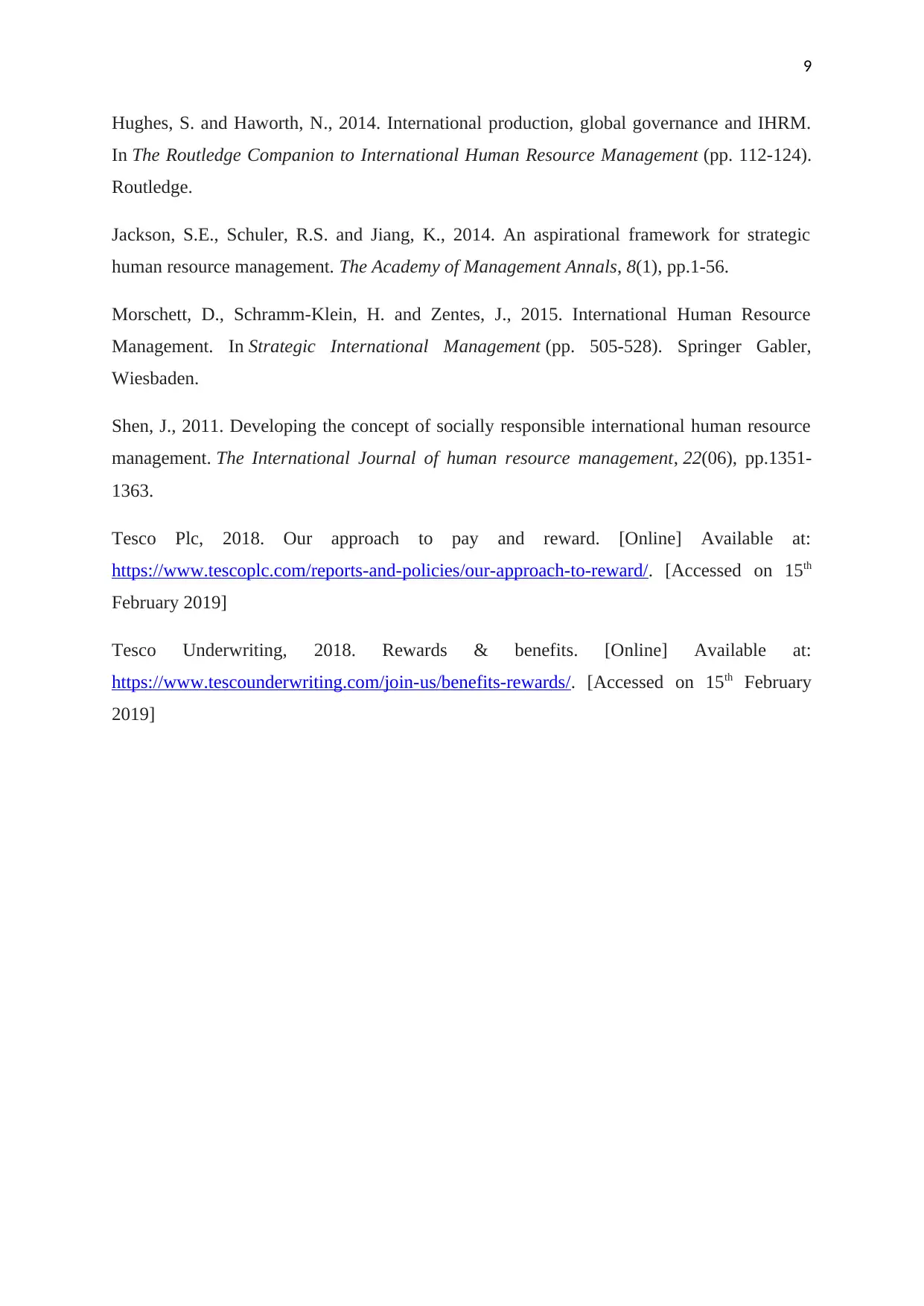
9
Hughes, S. and Haworth, N., 2014. International production, global governance and IHRM.
In The Routledge Companion to International Human Resource Management (pp. 112-124).
Routledge.
Jackson, S.E., Schuler, R.S. and Jiang, K., 2014. An aspirational framework for strategic
human resource management. The Academy of Management Annals, 8(1), pp.1-56.
Morschett, D., Schramm-Klein, H. and Zentes, J., 2015. International Human Resource
Management. In Strategic International Management (pp. 505-528). Springer Gabler,
Wiesbaden.
Shen, J., 2011. Developing the concept of socially responsible international human resource
management. The International Journal of human resource management, 22(06), pp.1351-
1363.
Tesco Plc, 2018. Our approach to pay and reward. [Online] Available at:
https://www.tescoplc.com/reports-and-policies/our-approach-to-reward/. [Accessed on 15th
February 2019]
Tesco Underwriting, 2018. Rewards & benefits. [Online] Available at:
https://www.tescounderwriting.com/join-us/benefits-rewards/. [Accessed on 15th February
2019]
Hughes, S. and Haworth, N., 2014. International production, global governance and IHRM.
In The Routledge Companion to International Human Resource Management (pp. 112-124).
Routledge.
Jackson, S.E., Schuler, R.S. and Jiang, K., 2014. An aspirational framework for strategic
human resource management. The Academy of Management Annals, 8(1), pp.1-56.
Morschett, D., Schramm-Klein, H. and Zentes, J., 2015. International Human Resource
Management. In Strategic International Management (pp. 505-528). Springer Gabler,
Wiesbaden.
Shen, J., 2011. Developing the concept of socially responsible international human resource
management. The International Journal of human resource management, 22(06), pp.1351-
1363.
Tesco Plc, 2018. Our approach to pay and reward. [Online] Available at:
https://www.tescoplc.com/reports-and-policies/our-approach-to-reward/. [Accessed on 15th
February 2019]
Tesco Underwriting, 2018. Rewards & benefits. [Online] Available at:
https://www.tescounderwriting.com/join-us/benefits-rewards/. [Accessed on 15th February
2019]
1 out of 10
Related Documents
Your All-in-One AI-Powered Toolkit for Academic Success.
+13062052269
info@desklib.com
Available 24*7 on WhatsApp / Email
![[object Object]](/_next/static/media/star-bottom.7253800d.svg)
Unlock your academic potential
Copyright © 2020–2025 A2Z Services. All Rights Reserved. Developed and managed by ZUCOL.




